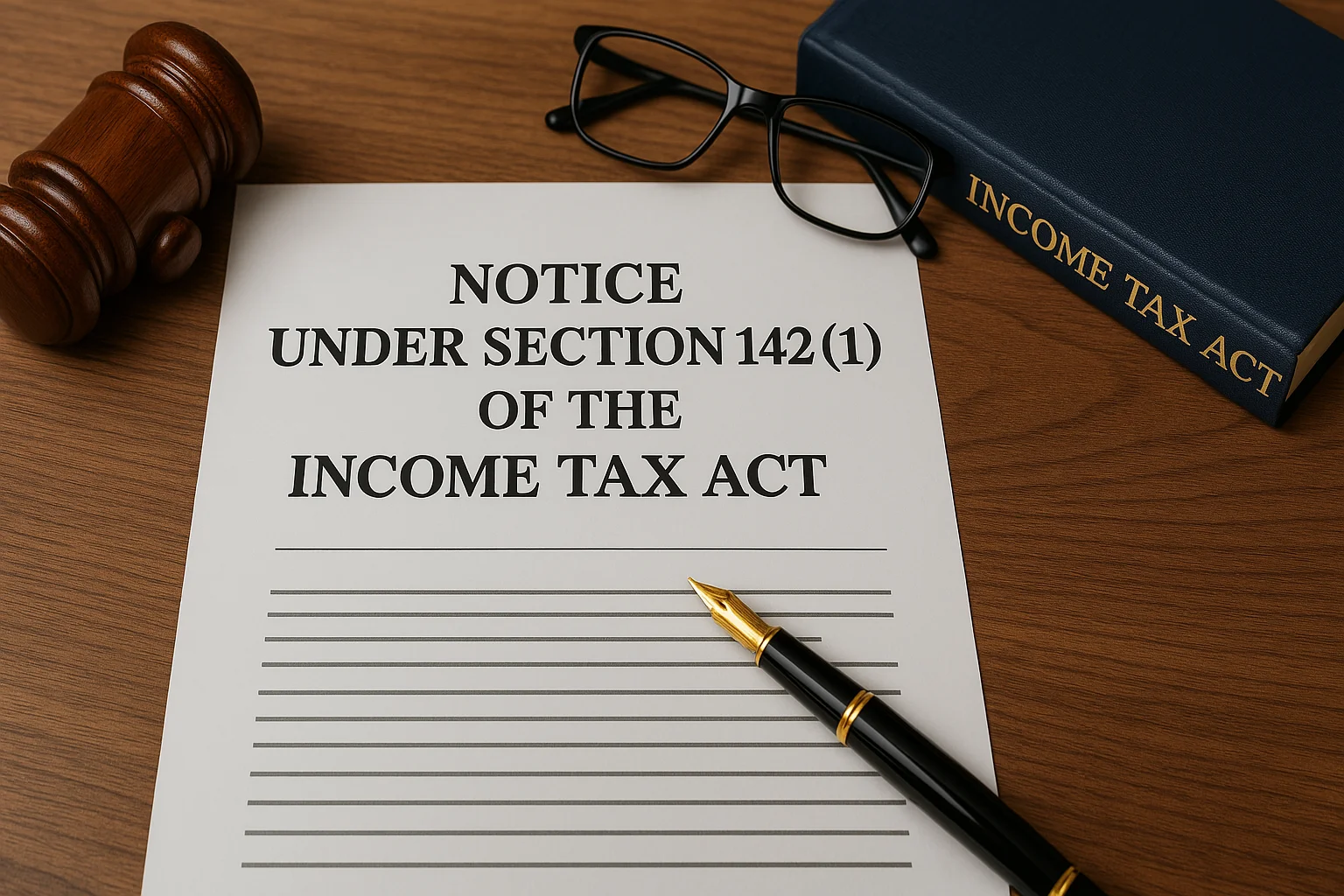Understanding Notice Under Section 142(1) of the Income Tax Act: A Complete Guide
The Income Tax Department issues various notices as part of its assessment process, and one of the most common is the notice under Section 142(1) of the Income Tax Act, 1961. This notice serves as an inquiry before the final assessment and requires your prompt attention and accurate response. Whether you’ve filed your return or not, understanding the nature of this notice, why it’s issued, and how to respond effectively is crucial to avoid penalties and complications. This comprehensive guide covers everything you need to know about handling a Section 142(1) notice.

Magnifying glass examining an official Income Tax Notice under Section 142(1)
What is Section 142(1) of the Income Tax Act, 1961?
Section 142(1) of the Income Tax Act empowers the Income Tax authorities to issue a notice requesting additional information or clarifications regarding your income tax return. This notice is a formal inquiry mechanism that helps tax officials verify the accuracy of your tax filings or gather information if you haven’t filed a return.
Purpose and Scope of the Notice
The primary purpose of a Section 142(1) notice is to ensure that the tax authorities have complete and accurate information for a proper assessment of your tax liabilities. This notice serves multiple functions:
- To request filing of an income tax return if you haven’t already done so
- To seek clarifications on specific entries or disclosures in your filed return
- To collect comprehensive financial data through accounts and supporting documents
- To verify the accuracy of reported figures and claimed deductions
- To ensure compliance with tax laws and proper calculation of tax liability
Who Can Issue the Notice? (Assessing Officer - AO)
The power to issue a notice under Section 142(1) primarily rests with the Assessing Officer (AO). Other authorities who may issue this notice include:
- Joint Commissioner in special cases requiring higher authority
- Commissioner in complex cases
The Assessing Officer has the authority to issue this notice whether you have filed your return or not, and even after the end of the relevant Assessment Year.
When Might You Receive a Notice Under Section 142(1)?
There are several circumstances under which you might receive a Section 142(1) notice:
Failure to File Income Tax Return (ITR)
If you haven’t filed your income tax return within the time specified under Section 139(1), the Assessing Officer can issue a notice requiring you to file your return within the time given in the notice. This notice can be issued even after the end of the relevant Assessment Year.
Need for Verification of Filed ITR
Even after you have submitted your return, the department might need further details to verify certain information. In such cases, they send a notice under Section 142(1) asking you to provide the required clarifications.
Discrepancies or Inconsistencies in ITR
If the Assessing Officer finds discrepancies or inconsistencies in your filed return, such as a mismatch between your reported income and the information in Form 26AS or other sources, they may issue this notice.
High-Value Transactions
If you’ve engaged in high-value transactions that appear inconsistent with your declared income, the tax department might issue a Section 142(1) notice to seek explanations.
Random or Mandatory Scrutiny
In some cases, returns are selected for scrutiny randomly or based on certain criteria, leading to issuance of this notice as part of the scrutiny process.
Requirement for Tax Audit / Specific Information
The notice may be issued to request specific information or documents, including tax audit reports if applicable to your case.
Non-Disclosure of Assets (including Foreign)
If the tax department suspects non-disclosure of assets, particularly foreign assets, they may issue this notice to gather more information.
What Information & Documents Can Be Requested in a Section 142(1) Notice?
A Section 142(1) notice can request various types of information and documents:
Request to File ITR
If you haven’t filed your income tax return, the notice will direct you to file it within a specified timeframe.
Production of Accounts & Financial Documents
The Assessing Officer may require you to produce specific accounts or documents, such as:
- Bank statements and transaction records
- Invoices and receipts for business expenses
- Evidence supporting deductions claimed
- Investment proofs
- Loan documents
Statement of Assets and Liabilities
You may be asked to furnish a statement of all assets and liabilities not forming part of your books of accounts. However, the Assessing Officer must obtain prior approval from the Joint Commissioner before requesting this information.
Clarifications on Specific Entries/Deductions
The notice may seek written explanations, notes, or workings on particular points that might not be part of your formal books of accounts.
Audit Report / Direction for Audit
In some cases, the AO may ask for audit reports or direct that an audit be conducted.
Note: The Assessing Officer cannot ask for any information or documents older than 3 years prior to the previous year.
How to Respond to a Notice Under Section 142(1) - Step-by-Step Guide
Responding correctly to a Section 142(1) notice is crucial to avoid penalties. Here’s a step-by-step guide:
Understanding the Notice Requirements & Deadline
Start by carefully reading the notice to understand exactly what information is being requested and by when. Typically, the Assessing Officer gives 30 days from the date of receipt of the notice to respond, though this timeline can be shortened or extended at the AO’s discretion.
Gathering Accurate Information & Documents
Collect all relevant records, receipts, invoices, bank statements, and any other supporting documents mentioned in the notice.
Preparing the Response
Based on the requirements in the notice, prepare your response with all necessary information and supporting documents. Ensure all information is accurate and complete.
Submitting Response via Income Tax E-filing Portal (e-Proceedings)
The response must be submitted electronically using the ‘e-Proceedings’ utility in your registered e-Filing account. Here’s how:
- Log in to the income tax portal and access your e-Filing account
- Navigate to the ‘Pending Actions’ tab and select ‘E-Proceedings’
- Click on ‘View Notices’ to see the notice issued under Section 142(1)
- Select ‘Submit Response’
- Choose the response type:
- Partial Response: If you can provide only some of the requested information immediately
- Full Response: If you’re ready to submit all required details and documents
- Upload necessary attachments in the allowed formats (PDF, Excel, or CSV)
- Click ‘Continue’ and check the ‘Declaration and Submit’ box
- Submit your response
Keeping Records (Acknowledgement)
After submission, you’ll receive a confirmation message indicating your response has been “Submitted Successfully.” Download and save this acknowledgment for your records.
Seeking Professional Help
If the notice is complex or you’re unsure about how to respond, consider seeking help from a tax professional such as a Chartered Accountant or tax consultant.
Requesting an Extension (If necessary)
If you need more time to gather all required information, you can request an extension by explaining the reasons for the delay and providing a timeline for submission.
Consequences of Not Responding or Providing Inaccurate Information
Failing to comply with a Section 142(1) notice can result in serious consequences:
Penalty under Section 271(1)(b) (Rs. 10,000)
A penalty of Rs 10,000 may be imposed if you do not respond as required under Section 271(1)(b) of the Income Tax Act.
Best Judgment Assessment (Section 144)
If you don’t respond to the notice, the Assessing Officer can conduct a “Best Judgment Assessment” under Section 144. This means the AO will assess your tax liability based on whatever information they have, which could result in a higher tax demand.
Prosecution under Section 276D (Imprisonment/Fine)
Non-compliance can lead to prosecution under Section 276D, which carries a potential imprisonment of up to 1 year, with or without a fine.
Potential Search Warrant (Section 132)
In certain cases, the authorities may issue a warrant under Section 132 to conduct a search.
Increased Future Scrutiny, Adjustment of Refunds, Interest
Non-compliance may also lead to increased scrutiny of your future returns, adjustment of any refunds against the additional tax demand, and interest charges on unpaid taxes.
Section 142(1) vs. Section 143(2) Notice: Key Differences
Understanding the difference between these two common notices is important:
| Parameter | Section 142(1) | Section 143(2) |
|---|---|---|
| Purpose | Inquiry before assessment | Detailed scrutiny assessment |
| Stage | Initial information gathering | Secondary detailed examination |
| Scope | Specific documents or return filing | Comprehensive scrutiny of return |
| Timeline | No specific time limit | Must be issued within 6 months of filing |
A notice under Section 142(1) is primarily an inquiry notice asking for specific information or documents, while a notice under Section 143(2) initiates a detailed scrutiny assessment after you have filed your return.
Recent Updates & Faceless Assessment Scheme
Impact of Faceless Assessment on Section 142(1) Process
The Faceless Assessment Scheme, introduced in 2019 (previously known as e-Assessment Scheme), has significantly changed how Section 142(1) notices are processed:
- All assessment proceedings are conducted electronically without direct, in-person interactions between taxpayers and assessing officers
- Cases are assigned randomly to assessment units across the country
- The process is managed through the National e-Assessment Centre (NeAC) and Regional Assessment Units (ReACs)
- This system aims to ensure transparency, efficiency, and reduce bias in the assessment process
If the Assessing Officer is not satisfied with your response to the Section 142(1) notice, they may initiate a scrutiny assessment through this faceless process. Your case will be evaluated remotely based on the documents and information submitted.
Increased Scrutiny on Household Expenditures
A recent trend in Section 142(1) notices is the increased focus on household expenditures:
- The Income Tax Department has begun issuing notices seeking detailed information on personal expenses
- These notices request comprehensive details about family members, their income, and day-to-day expenses
- Taxpayers are being asked to provide breakdowns of expenses on ration, utilities, clothing, schooling, insurance, and even social events
- If these details are not provided, the department may assume a household withdrawal (which could be around Rs. 10,00,000 for the financial year), potentially increasing tax liability
This trend indicates a stricter approach to verifying whether declared income is sufficient to support taxpayers’ lifestyles and expenses.
Frequently Asked Questions (FAQs)
Can I get a notice even if I filed my return?
Yes, a notice under Section 142(1) can be issued even if you have filed your return. This happens when the Assessing Officer needs additional information or clarification about certain aspects of your return.
What is the time limit to respond?
Typically, you have 30 days from the date of receipt of the notice to respond, though this timeline can be modified at the discretion of the Assessing Officer. Always check the specific deadline mentioned in your notice.
Do I need to visit the Income Tax Office?
No, you do not need to visit the Income Tax Office. All responses must be submitted electronically through the ‘e-Proceedings’ utility on the income tax e-filing portal.
What if I can’t provide all documents?
If you cannot provide all requested documents, you should submit what you have as a partial response, explaining the reasons why certain documents cannot be provided and, if possible, when they will be available.
Is there a time limit on which year’s accounts can be asked?
Yes, the Assessing Officer cannot request accounts or documents related to a period more than three years before the previous year.
What happens after I submit my response?
After submission, the processing department will review your response. If the AO finds your response satisfactory, your ITR will be processed without further action. However, if the AO is not satisfied, they may issue a notice under Section 143(2) to initiate a scrutiny assessment.
